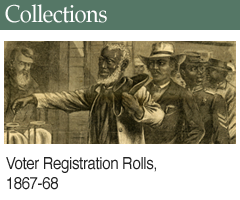Florida's Historic Constitutions
Florida's constitution outlines its form of government, including the powers and responsibilities of state and county officials. The current constitution was framed by a constitutional revision commission and approved in 1968, but many of its provisions date back to the 19th century.
Included here are the original manuscripts or contemporary copies of each of Florida's 19th century constitutions, plus the 1812 constitution of the short-lived Republic of East Florida and the state's 1861 Ordinance of Secession.

"Patriot Constitution" of the Republic of East Florida, 1812
In March 1812, a group of Georgians and residents of Spanish East Florida attacked and occupied Fernandina on Amelia Island. Calling themselves the “Patriot Army,” they aimed to convince more citizens of East Florida to join their movement and overthrow the Spanish colonial government. Their hope was for East Florida to then be annexed to the United States as a territory. The so-called Republic of East Florida was short-lived and ultimately unsuccessful, but its leaders did produce this constitution.
Constitution of the State of Florida, 1838
Florida’s original state constitution was drafted by a convention of 56 prominent Floridians in the coastal town of St. Joseph in late 1838 and early 1839. The delegates drew inspiration for the document from neighboring states, especially Alabama. The people of Florida ratified the new constitution, but only barely, and Congress did not admit the territory as a new state until 1845.
Ordinance of Secession, 1861
Many Floridians interpreted the election of President Abraham Lincoln in November 1860 as a dangerous step toward the abolition of slavery. When the Florida Legislature convened later that month, the members passed a law calling for a “Convention of the People” to determine how the state would respond to the crisis. Delegates were elected by popular vote in December, and the convention met in Tallahassee in January 1861. The delegates voted 62-7 to withdraw Florida from the Union, making it the third state to secede. The convention also made numerous changes to the state constitution, altering the terms of office for many officials and deleting references to the United States.
Constitution of the State of Florida, 1865
Civil government was suspended when the Union military first occupied Florida in May 1865. Hoping to return the former Confederate states to the Union as quickly as possible, President Andrew Johnson appointed Judge William Marvin of Key West as provisional governor and directed him to call a constitutional convention. The delegates annulled the Ordinance of Secession and framed a new state constitution that recognized the end of slavery. The life of this document was a short one, however. The Republican majority in Congress, unsatisfied with the former Confederate states’ limited acceptance of freedom for African Americans, passed the Reconstruction Acts over President Johnson’s veto and reestablished military control in the South.
Constitution of the State of Florida, 1868
Under the Reconstruction Acts, Congress assumed control over readmission of the former Confederate states to the Union. The United States military reoccupied those states and caused all eligible men over 21, regardless of race, to be registered to vote. Each state’s newly enfranchised electorate then selected delegates to frame a new state constitution and submit it to Congress for approval. Florida’s constitutional convention met in January 1868, and the voters ratified the final document on May 4, 1868. Congress officially declared Florida back in the Union later that year on July 25.
Constitution of the State of Florida, 1885
The contents of Florida’s 1868 constitution were profoundly shaped by the dominance of the Republican Party and the enfranchisement of African Americans for the first time. By the early 1880s, however, conservative Democrats controlled state politics and wanted to reverse some of the old document’s provisions. A convention met in Tallahassee in June 1885 and drafted a new state constitution, which was ratified by the people in November 1886. Many offices that had previously been filled by appointment were made elective under the new document. Segregation of public schools was made mandatory, poll taxes were legalized and intermarriage between whites and African Americans was prohibited.

 Listen: The Blues Program
Listen: The Blues Program


